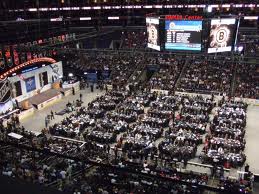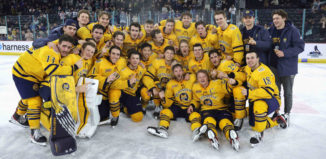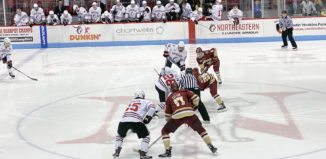Age Eligibility in Minor League Hockey
(Photo: powerplaymanager.com)
It’s routinely cited as one of the most memorable day of any hockey player’s life: draft day. Hockey players can get drafted into the National Hockey League at 18 years old. There is no requirement about being a year out of high school or completing some amount of college, like in the NBA or NFL.
But what happens if the players are not ready to join the NHL team that drafted them at just 18 years old? A select few taken in the first round will attempt to make the jump. However the rest of the draft picks from the seven rounds need more time to develop. What happens to them?
That’s where it gets a little more complicated. Every NHL team has an AHL affiliate that they use to develop players. In many cases, they also have established relationships with ECHL teams. What could be a better situation for a young player that needs that little something extra before making it to the NHL?
Unfortunately, it’s not that simple. Although a player can go straight to the NHL following the draft, the rules are cloudier when it comes to playing in the AHL. Per the AHL By-Laws, players must be 18 years old by September 15th of the season that they would start playing. However, players don’t often join the AHL before they are 20 years old.
There are a couple different reasons that players do not join the AHL right away. Most of these players are playing for a junior team somewhere, in Canada or the US, or are playing for a team in Europe or Russia. They might have good relationships with the coaching staff on those teams. If they cannot go straight to the NHL, staying with a coach that knows them can make sense. Those that know them are often the best to aid in their continued development.
If that were the only reason, it would be one thing. The players would be making the choices themselves with nothing stopping them from joining the AHL if they wanted to after being drafted. The choice would only come down to what each player, and those advising him, thought was best for development. It would be the player’s choice instead of being decided by the team he was with when he was drafted.
However, the decision to come to the AHL prior to turning 20 years old is not always one that belongs to the player. The exact rule governing when players can join the minor professional hockey leagues can be complicated and has different facets depending on where the player was playing when he was drafted.
The first agreement impacting players turning pro in the minor professional hockey leagues is the NHL-CHL agreement. The Canadian Hockey League, or CHL, is the organization that oversees the Ontario Hockey League (OHL), Western Hockey League (WHL), and Quebec Major Junior Hockey League (QMJHL). These are the three main junior leagues in Canada and are responsible for providing a large number of draft picks each year.
Understandably, the CHL wants to protect the competitive nature of their leagues and does not want their top talent leaving as soon as they get drafted. For that reason, the CHL and NHL reached an agreement.
Any player already playing for a team in the CHL when he is drafted will be ineligible to play for the minor professional leagues until he is 20 (by December 31st of that season) or has played four seasons in the CHL. For example, the Edmonton Oilers selected Darnell Nurse in the first round of the 2013 NHL Entry Draft from the Sault Ste Marie Greyhounds. He has played three seasons in the OHL so far and will not be 20 until February of 2015, making him ineligible to play in the AHL if he does not make Edmonton this season.
This is the rule for any player in the in the Canadian Hockey League. But some players that end up in the CHL do not have to follow these rules. If a player is with any team not in the CHL when he is drafted, these rules do not apply. Sometimes a player gets drafted and then decides to join one of the leagues in the CHL. What happens then?
The Washington Capitals selected Andre Burakovsky in the first round of the 2013 Draft. Playing in Sweden prior to being drafted, he was outside the rules of the CHL. After the draft, he did not make the Capitals and instead, made the jump to an OHL team. Since he was not in the CHL prior to his draft, he could decide to join the AHL for the 2014-15 season even though he will still be 19 years old and has only played one OHL season. This is true for any player from the United States, Europe, or Russia that follows the same path as Burakovsky.
Finally, players that go to the NCAA (in the US only, Canadian colleges are excluded) also play by their own rules. As long as they are 18 years old, they can join the AHL whenever they would like. The flip side to that is that the second they sign a contract they will be ineligible to return to the NCAA. They have then gained professional status.
This also only applies when players are looking to start a season with a team outside the NHL. Players from OHL, WHL, and QMJHL routinely join AHL teams after their seasons end for the remainder of the AHL team’s season. That is okay.
So, at the end of the day, are players that are in the CHL when they are drafted into the NHL at a disadvantage? If they feel like they have outgrown the competition in the CHL at 18 or 19 years old, but are not ready for the NHL, there is no option for them to move on. They are forced to stay with their team while other players make the jump sooner. Of course, many players are probably happy to stay with the juniors teams. But the choice should be theirs.
It would be one thing if these rules were in place for all drafted players and every player was on even footing. The way the rules are now, though, singles out players in the CHL for no other reason than that the league wants to protect the level of competiveness. That does not seem to be a good enough reason to give a certain group of players a different classification. Most CHL players participate in those leagues because they are Canadian and the CHL is seen as the best of the best. They should not be kept from joining professional hockey if that is what they want to do.















[…] The Pink Puck highlights some issues with age eligibility rules in minor league hockey. [The Pink Puck] […]
“If they feel like they have outgrown the competition in the CHL at 18 or 19 years old, but are not ready for the NHL, there is no option for them to move on.”
They could still go to Europe and play in a men’s league, right?